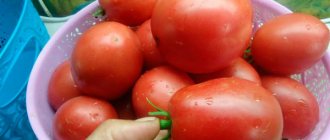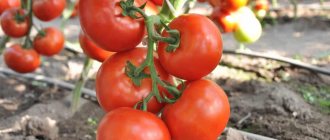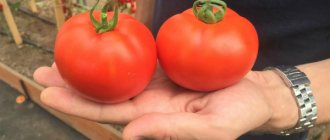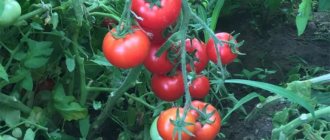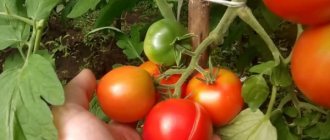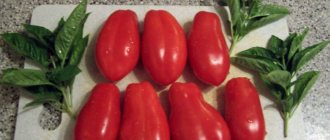Description of the Babushkino variety
The Babushkino tomato is a large-fruited species. It is suitable for growing in greenhouses and open ground. The ripening period is mid-early. From the moment the shoots emerge until the first tomatoes are harvested, an average of 120 days pass. The bushes are tall, indeterminate, and can grow more than 2 meters in height, so they are recommended to be grown on a trellis. Leaves have a classic shape and are medium in size.
Up to 4 fruits are formed on each brush
Up to 4 fruits are formed on each brush. With proper care, the fruits can reach a weight of 1000 g, but more often gardeners grow tomatoes weighing 220-380 g. The shape is rounded-flat, the ribs are weakly expressed. After full ripening, the tomato acquires a beautiful red-pink color; there is no green spot on the stalk, but a yellow spot may appear. The skin is dense but thin and edible. The pulp is moderately dense, with a high content of juice, pink in color. Not a lot of seeds. The taste is pleasant, it harmoniously combines sweetness and sourness.
Important!
With proper care and timely feeding, the Babushkino tomato can grow up to 1 kg! Such record holders, of course, need to be tied up so that the branch on which they grow does not break off.
Characteristics
“Babushkino” can be classified as a mid-early tomato variety; the fruits ripen approximately 110-120 days after sowing the seeds. It can be grown throughout the Russian Federation, both in a greenhouse and in the garden. The plants are indeterminate, reaching a height of 2-2.2 meters.
The fruits are large, weighing 300-400 grams, but some tomatoes can reach 800 grams, flat-round in shape, sometimes ribbed near the stalk. The skin is smooth, dense, and turns red-pink when ripe. The pulp is fleshy, tender, has few seeds, and has several chambers. Tomatoes have a high dry matter content. The taste of the fruit is excellent.
The variety was bred relatively recently by amateur breeders, so the seeds are not so easy to find, since large companies do not distribute them; you can buy them from collectors. Plants are resistant to many diseases common among tomatoes and tolerate temperature changes well. But, unfortunately, judging by the reviews of gardeners, tomatoes are susceptible to cracking. To avoid this, it is necessary to monitor soil moisture and not overwater the plants.
Tomatoes are suitable for fresh consumption and for winter storage, except for whole-fruit canning, since they simply will not fit into a jar. You can use them to prepare juices, purees, sauces and dressings. The yield is excellent, 4-6 kilograms per plant. The variety is not a hybrid, so next season you will no longer need to spend money on seeds. It is better to collect seeding material for the next year from late fruits; they contain much more seeds than early ones.
Characteristics of Babushkino tomato
Also check out these articles
- Pear variety Forest Beauty
- Description of the eggplant variety Black Beauty
- Wheat bran
- Sow farrowing pen
Gardeners note many positive characteristics of the Babushkino variety.
With proper care and timely feeding, the Babushkino tomato can grow up to 1 kg!
- Pest attacks, with timely treatment, do not affect the plant.
- There is stable immunity to viruses and fungal diseases.
- Productivity is high. From a bush you can collect 5 kg of fruits per season, and from a square meter - 22 kg of tomatoes.
- Plants are resistant to climate change, sudden decreases or increases in temperature.
- The fruits are large and fragrant.
- The taste is excellent.
- Fruits do not perform well when transported even over short distances.
In general, judging by the quality of the fruit and their taste, we can say that the Babushkino tomato deserves a place on the plot. It makes very tasty lecho, juice, pasta and other similar dishes.
Important!
The Babushkino tomato variety has virtually no sour taste, for which it is valued by many gardeners.
The pulp is moderately dense, with a high juice content
Landing
If you are confident in the quality of the seed material and the reliability of the manufacturer, then Babushkin tomato seeds do not require preliminary preparation.
They are embedded in grooves to a depth of 1.5 cm in moist soil. The container with seeds is covered with plastic or glass. Can be covered with film. The seedlings are ventilated daily and watered as the soil dries.
When three full leaves appear, the seedlings are planted in separate pots.
Landing schedule
- March 20-30 Sowing seedlings
- April 10 – 20 Dive
- June 1-10 Planting in the ground
If the planting schedule is followed, the first harvest can be obtained in mid-July. Fruiting will last until September.
Landing in the ground
Grown seedlings are planted in open ground in prepared holes at a distance of 50 cm between plants. The distance between the rows is 60 cm. Planting bushes in a checkerboard pattern will help save space on the site.
To prevent diseases and as an organic fertilizer, add a tablespoon of sifted wood ash to the holes before planting. After that, the holes should be thoroughly watered. So that the roots do not get burned.
Disadvantages of the Babushkino variety
The main disadvantage of this variety is that it is difficult to find quality seeds. Since it is not registered, counterfeits are often sold under its guise - this is important to consider. Most gardeners rely on conscientious collectors to love and grow this variety year after year.
- The fruits may crack severely. The larger the fruit, the larger and deeper the cracks. At the same time, of course, the marketability of tomatoes decreases.
- Despite their commercial qualities, the fruits are difficult to sell, because when they reach the market, they become very soft and lose all their attractiveness.
- Not suitable for whole canning.
- Plants are demanding when it comes to feeding.
Babushkino tomato seeds must be purchased from variety lovers and breeders, since they are almost never sold in stores
Important!
Babushkino tomato seeds must be purchased from lovers of the variety and breeders, since they are almost never sold in stores.
It is also necessary to take into account that the variety is not included in the State Register. There are no recorded exact characteristics. Many gardeners are disappointed in Babushkino tomatoes in the first year of cultivation, as they do not meet the expectations and overvaluation of lovers of the variety.
Features of cultivation and care
This variety can be grown by sprouting seedlings from seeds. In northern regions, seeds should not be planted immediately. They must first be sown in a container and left in the room for germination. This procedure is performed in early spring. It is better to purchase soil at the store; you can also add a little fertilizer there to enhance growth. After the seeds hatch, the seedlings need to be placed in a bright place and continue to grow at room temperature.
The soil in the garden must first be dug up, fertilizer added, everything loosened and watered. Since the bushes usually grow too long, they must be tied up immediately with ropes. Otherwise, branches and shoots may break under the weight of the tomatoes.
You should also leave a gap between the plants when planting, so it will be more convenient to move there, and more light and nutrition will reach the bushes.
If the soil is rich and high-quality watering is provided, and care is taken carefully, then the variety will delight you with ripe, tasty tomatoes already in August.
Since the Babushkino variety is a tomato that requires regular watering and good soil. If all this is provided, the yield and taste of tomatoes can be increased. After all, the taste of tomatoes directly depends on human care.
Care requirements:
- Tomatoes should be watered regularly, use settled water, and the beds should not be over-flooded;
- It is necessary to constantly loosen the soil, so the plant roots will receive more nutrition;
- Fertilizers are applied before planting in the ridges, during flowering and fruiting. To do this, you should definitely use peat, manure, mineral fertilizers and organic matter;
- To protect plants from parasites, bushes should be treated for prevention with special compounds;
- For a bountiful harvest, pinching should be done as often as possible. Excess leaves are also removed so that they do not cover the fruits from sunlight and interfere with fruiting;
- It is necessary to regularly weed out weeds, as their appearance negatively affects tomato bushes;
- Greenhouses should be ventilated so that moisture does not stagnate there; this will also harden the plants;
- The bushes are tied up when they are young so that they do not bend or break, and the shoots are also secured;
- Tomatoes love fertilized soil. Therefore, due to a lack of potassium, phosphorus or magnesium, they will begin to hurt, become stained, wither and rot.
Read also: Strekar, LLC - BAIS-YUG
Tomato seedlings Babushkino
We recommend reading our other articles
- Bee pollen
- The best varieties of tomatoes for greenhouses
- How to properly plant radishes in a greenhouse and open ground
- Borscht dressing
The easiest way to grow Babushkino tomatoes is through seedlings. Seeds are sown in early March to be planted in a permanent place in mid-May. If the seedlings are planted in the ground later, then the seeds are sown at the end of March.
In advance, the seeds are soaked in water for 2-3 days (the water must be constantly changed). Containers for growing seedlings need to be filled with soil and compacted. It is advisable to pour a weak solution of potassium permanganate to disinfect.
The easiest way to grow Babushkino tomatoes is through seedlings
The hatched seeds are laid out directly on the surface of the soil and sprinkled with a thin layer of soil. Place the seeds at a distance of 2-3 cm from each other. After sowing, you need to water the soil with water (it’s better to spray it with a spray bottle) and cover it with a plastic bag or glass. They should germinate at a temperature of +26 degrees.
When the seeds hatch, you need to remove the film and lower the temperature to +15 degrees for 1 week so that they do not stretch. After a week, you can raise the temperature again to +21 degrees. It is at this temperature that tomato seedlings should be grown until hardening.
Caring for seedlings is not labor-intensive. You need to water it on time, if desired, fertilize it with complex fertilizer when 2 leaves appear. It also doesn’t hurt to drop the sprouts into separate cups. This way they will develop better. But many gardeners do without picking.
It is necessary to water the seedlings on time and, if desired, fertilize them with complex fertilizer
If picking is carried out, then you need to choose good cups (preferably peat or paper) and fill 1/3 with soil. Then the tomatoes are taken out of the old container, carefully digging in with a knife, and then transferred to a new glass and covered with soil. The seedling can be buried down to the cotyledon leaves. After planting, the soil is watered and placed in a bright place.
Interesting!
If, when picking sprouts into separate cups, you tear off the lower part of the root by 1/3, the root system will develop better.
Growing rules
To get a large harvest of large Babushkino tomatoes, you must follow all growing recommendations. Planting is carried out through seedlings in open ground or a greenhouse, depending on the climate.
Planting seedlings
Seeds for seedlings are sown approximately 2 months before planting in a permanent place. Usually this is the end of March or the first ten days of April. The soil is warmed up and then the seeds are planted there. The soil should be loose and fertilized. After sowing, the container is covered with film and placed in a warm place. Provide regular but moderate watering.
When the sprouts hatch, the film is removed and the plants are provided with good lighting. Seedlings need to be fed 2-3 times with mineral fertilizers. Picking is done when two true leaves appear. This way the root system grows better. Before planting in a permanent place, the plants must be hardened off. This procedure is carried out by gradually reducing the temperature and time the plants stay in new conditions.
Tomato transplant
Seedlings are planted in a greenhouse in mid-May, and in open ground in early June. By this time, the tomatoes should already have 6-8 true leaves. The ground is pre-fertilized and dug up.
Tomatoes are planted in holes at the rate of 4 bushes per 1 square meter. m. The plants are quite large, so plantings cannot be thickened. It is better to maintain a distance of 50 cm between bushes.
Subsequent care for tomatoes
Tomato varieties Babushkino need to be shaped. Leave 1-2 stems, removing the remaining shoots, otherwise the fruits will be smaller. These tomatoes require pinching. Since the bush is tall, it must be tied to pegs or a trellis. The fruits are very large, so you also need to fix each brush.
Fertilizing should be applied as often as possible - the plant spends a lot of energy on the formation of tomatoes. Mineral fertilizers and organic matter are suitable. If the tomato turns yellow near the stalk, then you need to add potassium and magnesium.
The soil is periodically loosened and the bushes hilled up. Weeding is also necessary to prevent weeds from interfering with the tomatoes. Mulching is recommended to effectively retain moisture in the soil. Water Babushkino tomatoes with warm water. Moderation must be observed, otherwise, with sudden changes in moisture in the ground, the fruits will begin to crack. Preventive treatment against pests and diseases is carried out during the flowering period.
The harvest can be harvested with slightly unripe fruits; the main thing is not to leave ripe tomatoes hanging on the branches for a long time. Babushkino has been producing tomatoes for a month and a half.
Features of planting tomatoes
Tomato variety Babushkino can grow in different types of soil, but it must be fertilized and have normal acidity. Ideally, the site should be protected from winds and sunny. Planting is carried out when the threat of return frosts passes.
Important!
Tomatoes should not be planted after nightshades, otherwise diseases and pests will be difficult to avoid.
If the seedlings grew in peat cups, then you can plant the sprouts with them
Planting is carried out in holes located at a distance of 40-50 cm. Row spacing is done with a distance of 50-70 cm. Seedlings ready for transplanting are taken out of the pots and planted in the holes. If it grew in peat cups, then you can plant the sprouts with them. During planting, it is not strongly recommended to bury the sprouts, but it is even a little useful for the development of the root system.
Reviews, who planted
Marisha, St. Petersburg
This Babushkino variety grew in two shoots in a greenhouse, grew to 220 cm, the tomatoes are large, round, bright red and very fleshy, the taste is sweet, and the weight is about 400 grams, there were 5 tomatoes in a bunch. The yield is high and the keeping quality is good, so I will definitely plant it next year.
Veronica, Moscow
The variety is quite productive, the tomatoes are large and even at the top, but the downside was the shoulders, although there were not many sunny days. Another variety grew nearby, but it did not have shoulders, and the care was the same. Perhaps I did something wrong. Another time I will take into account that the variety is especially sensitive to a lack of potassium-magnesium.
Kalinka-Malinka, St. Petersburg
They grew in my greenhouse. At the beginning of summer, large clusters of large tomatoes appeared, which were very tasty. But then gaps began, and others formed a little smaller, but large ones began again near the ceiling. Most likely, the weather was suitable for the growth and formation of fruits.
Nadine, Volgograd
My weight of tomatoes reached 400 grams, there weren’t any too big, the first bunches were smaller, and then larger ones. I really liked it for its brightness, almost shiny tomatoes, all smooth, the taste is traditionally tomato, with sweetness, fruitful. Formed 3 shoots.
Rules for caring for Babushkino tomatoes
Many gardeners consider the variety to be unpretentious, but everyone has a definite opinion. In general, it is impossible to do without care, but there are no serious difficulties in growing it.
- Timely watering is essential for any tomato variety. This one is no exception. Watering is not frequent, but plentiful.
- The earth should not be crusted over. If this happens, it is loosened with a squeegee or similar garden tool.
- Removing weeds is necessary so that plants get sick less and get maximum benefit from fertilizing, watering, and loosening the soil.
Tomato Babushkino is grown on a trellis or high support
- The Babushkino tomato is grown on a trellis or high support, since the variety is indeterminate. As the bushes grow, you need to make sure that they cling to the support, without bending to the side. If necessary, tie up the bush.
- If large fruits ripen on the branches, it is advisable to tie them to a support so that the tomatoes do not fall when ripe.
- The plant must be properly shaped in order for it to produce enough yield. Bushes are formed into 2 and 3 stems.
- The plant reacts sharply to a lack of nutrients, so fertilizing must be applied in a timely manner. Fertilizers are applied organic and mineral. In this case, you need to alternate them.
Important!
The Babushkino tomato needs regular feeding. This issue needs to be given special attention!
Growing rules
Photos of ripe fruits and bushes simply covered with large tomatoes prompt many gardeners to buy seeds of the Babushkino variety. But to grow this tomato, you need to know some features.
Planting tomatoes
Like all tomatoes, in Russia Babushkino is grown through seedlings. Therefore, the first thing a gardener will have to do is to find the seeds of this tomato on sale. Of course, you can try to find ready-made seedlings, but this is difficult, since the variety is quite rare.
The gardener should act in the following sequence:
- Determine the timing of sowing seeds for seedlings. Like all tomatoes, the Babushkino variety is sown 1.5-2 months from the expected date of planting in a permanent place. The seedlings of this tomato are transferred to the greenhouse in early to mid-May, but tomatoes can be planted in the beds by the end of May - early June. Based on this, it is recommended to sow seeds at the end of March or early April.
- Seeds are sown in warm soil. The soil chosen is loose, well-fertilized, and capable of retaining moisture. Until the tomatoes germinate, they are kept under film in a warm place.
- You need to water the seedlings with warm water, this will speed up their development and protect them from diseases.
- You will need to feed the tomatoes with mineral fertilizers two or three times - the Babushkino variety really loves feeding.
- Be sure to pluck the seedlings when they grow two leaves. This stimulates the root system to grow and prepares the seedlings for planting in the ground.
- Before taking tomatoes into a greenhouse or garden bed, they must be hardened. This is done carefully and gradually, lowering the temperature every day and increasing the procedure time.
- When the outside temperature allows, and when the seedlings have 6-8 true leaves, they can be transferred to a permanent place.
- The holes are made in advance, after fertilizing and digging up the soil on the site. The distance between the holes should be large, because the Babushkino tomato bushes are powerful and tall. An interval of 50-60 cm between tomatoes is recommended.
The tomatoes are left untouched for the first couple of weeks; during this time they must adapt to new conditions. When the seedlings become stronger, new leaves begin to appear, you can feed the plants and begin to actively water them.
Tomato care
Reviews about the Babushkino tomato variety are contradictory, but those gardeners who paid a lot of attention to caring for their plantings were satisfied with this tomato. Like all indeterminate varieties, Babushkino needs regular and competent care.
As a tomato develops, it will need the following:
- Bush formation. It is customary to leave only two or three stems, removing the remaining stepsons, which will only lead to an increase in green mass and smaller fruits.
- A tall bush will definitely have to be tied up using pegs, a trellis or other supports. Powerful bunches of several large tomatoes often break branches, so each ripening bunch also needs to be strengthened.
- The Babushkino tomato is very sensitive to the composition of the soil - this tomato needs plenty of nutrition. Therefore, you need to feed tomatoes often and in large quantities. Both organic and mineral fertilizers are suitable.
- If the fruit's shoulders begin to turn yellow, add potassium and magnesium to the soil. After this, the ripening of the tomatoes should become more uniform.
- The bushes are hilled up, the ground is periodically loosened, and weeds are pulled out. You can use mulch to retain moisture.
- It is best to water the Babushkino tomato with warm water. Watering is especially important during the fruit filling stage, but excess water will lead to cracking, so the gardener must be careful.
- Diseases practically do not affect this variety; pests also rarely appear on bushes. For prevention purposes, it is still better to treat the bushes during the flowering period.
- The harvest must be ripe or slightly unripe. Fruiting of the Babushkino tomato is extended - for a month and a half, the plants will delight you with fresh fruits.
Diseases and pests of the variety
The variety is resistant to diseases, according to many gardeners. It should be borne in mind that there is not a single variety or hybrid of tomatoes that is resistant to all diseases. So some problems will still arise sooner or later.
The development of the disease can be prevented through preventive treatments. To do this, you can use specialized fungicides or some folk remedies. The first treatment is carried out approximately a week after transplanting the plant to a permanent place. It is important that the bush has time to take root. As the tomato grows, you can also treat the plantings 1-2 times to prevent the development of diseases.
Slugs, spider mites, whiteflies, wireworms, and aphids can settle on the Babushkino tomato.
If a disease does appear on the bushes, they are treated with specialized means - fungicides. The best are “Skor”, “Ridomil Gold”, “Revus”, “Quadris”. Therapeutic treatments are carried out strictly according to the instructions.
More problems arise not with diseases, but with pests. Slugs, spider mites, whiteflies, wireworms, and aphids can settle on the Babushkino tomato. A mole cricket can also cause a lot of damage. To combat them, you can use insecticides (Goodwin, Mospilan), acaricides (Sunmite, Apollo, Oberon). You can also destroy them using folk remedies: infusion of mustard, hot pepper, garlic, dandelion, setting traps and bait. These pests also do not like spraying with a solution of vinegar or whey.
Pest and disease control
The first treatment of seedlings is carried out in May - a week before transplanting into the greenhouse or immediately after that. Any fungicide can be used:
- "Tattu";
- "Profit";
- "Topaz";
- "Maksim";
- Bordeaux mixture.
Large insects and other pests (Colorado beetles, slugs) can be removed manually or washed off the plants with water. Then it is recommended to immediately treat with any insecticide:
- "Aktara";
- "Fitoverm";
- "Decis";
- "Confidor";
- "Biotlin."
You can also use folk remedies - an infusion of onion peels, garlic, chili peppers, a solution of baking soda, wood ash, tobacco dust. Colorado potato beetles can be dealt with using bait - pieces of potato in a jar dug into the ground. To repel slugs, you need to scatter crushed egg or nut shells next to the beds of Babushkino tomatoes.
Advice! Treatment of bushes should be carried out only in the late evening, in the absence of rain and strong winds.
After using the chemical, harvesting can be done no earlier than 5-7 days (depending on the waiting period specified in the instructions for the product).
Harvesting and processing the Babushkino tomato
The ripening of the first tomatoes can be observed from the beginning of June, if planted in a greenhouse in a timely manner. If the Babushkino tomato grows in open ground, then the first fruits are harvested about 2-3 weeks later. The duration of fruiting is about 2 months, but the main stage is 2-4 weeks. It is at this time that most fruits are harvested. Tomatoes are harvested immediately after ripening, otherwise they may crack and begin to rot.
It is best to make tomato juice from this variety.
The Babushkino tomato is used mainly for preparing salads and summer snacks, that is, fresh. For canning, it is best to make tomato juice, puree, borscht dressing, lecho, pasta and similar dishes from this variety. But the fruits are not suitable for canning in whole form due to their size. In addition, the thin skin quickly cracks in jars.
Summary
The Babushkino tomato variety definitely deserves the attention of both beginners and experienced gardeners. The main advantage of the tomato is its stability and fertility. All the disadvantages of the variety are associated with insufficient soil nutrition, so the gardener should pay special attention to fertilizing.
To collect your own planting material, you need to leave several large and beautiful fruits from the last ovary on the bushes. Reviews from those who have already planted this tomato are mostly positive; farmers especially note the excellent taste of the Babushkino tomato and the size of its fruits.
Reviews from gardeners about the tomato variety Babushkino
Opinions and reviews from gardeners about the Babushkino tomato variety differ.
- Mila Grishina : “I’ve been growing Babushkino tomatoes for the third year in a row. I bought the seeds from a friend who grows them. I always plant in a greenhouse, near a trellis, so that they produce an early harvest. If you pay close attention to the care, temperature and humidity in the greenhouse, they will not have time to crack before harvest. The taste is pleasant, the skin is thin. I only use it for fresh salads!”
- Sava Polyakov : “I like the Babushkino tomato for its taste, because the fruits are very large, and for their pleasant, tomato aroma. Unlike hybrids, they have a natural taste with sweetness, pleasant pulp. But, unfortunately, there are few seeds, and finding them in the store is not easy. And there are a lot of cracked fruits; they are poorly stored. Because of this, I won’t plant any more.”
- Antonina Medvedeva : “I plant Babushkino tomato every year for food. The whole family loves him. Of course, the harvest is not stored for a long time, and transporting it from the dacha is problematic, but it is worth the effort. Salads from it are made with vitamins, juice with a natural, pleasant taste. I don’t buy seeds, but collect them from grown tomatoes. They germinate poorly, so it’s better to leave at least 3 fruits per seed.”
Pros and cons of the variety
This variety of tomatoes has become popular and gained the trust of gardeners due to a number of advantages:
- It is low maintenance;
- High yields;
- Resistance to low temperatures;
- Resistance to various kinds of diseases;
- Delicious tomatoes;
- The versatility of fruit use.
Despite most of the positive aspects of the variety, there are still some disadvantages:
- Fruits may crack;
- A small number of seeds, which makes it difficult to prepare seed;
- Yellow spots on the stalk due to insufficient nutrition.
Judging by the demand among gardeners and the majority of positive reviews, the advantages of the Babushkino variety of tomatoes cover all its disadvantages. Yes, and some disadvantages can be eliminated if you adhere to the rules of care.
Advantages and disadvantages
The advantages of Babushkino tomatoes are as follows:
- the plant has no growth restrictions, so the height of the bush reaches up to 2.6 m;
- well suited for planting both in open ground and in a greenhouse;
- has very strong immunity to diseases and more than satisfactory frost resistance;
- with proper care, it is high-yielding, since up to 12 fruits appear on one cluster (on average per season, one plant can produce up to 5 kg of fruit yield);
- Due to its excellent taste, tomatoes of this variety are widely used in cooking.
The disadvantages include:
- the variety is not officially registered, so the seeds are not distributed by large companies;
- It is quite difficult to obtain seed material from fruits, since the first tomatoes may have no seeds at all;
- requires careful care, in particular, it is necessary to periodically fertilize with magnesium and potassium;
- When overripe, the fruits of this variety are prone to cracking.
